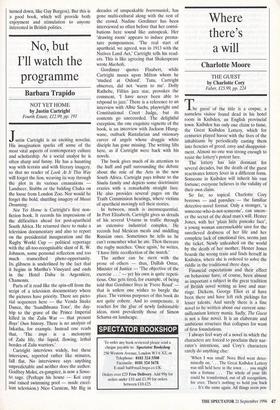No, but I'll watch the programme
Barbara Trapido
NOT YET HOME by Justin Cartright Fourth Estate, £12.99, pp. 191
Justin Cartright is an exciting novelist. His imagination sparks off some of the most vital aspects of contemporary culture and scholarship. As a social analyst he is often sharp and funny. He has a haunting way with terrain and with literary imagery, so that no reader of Look At It This Way will forget the lion, weaving its way through the plot in its various emanations — Landseer, Stubbs or the balding Chaka on the loose from London Zoo. Nor would he forget the bold, shuttling imagery of Masai Dreaming.
Not Yet Home is Cartright's first non- fiction book. It records his impressions of the difficulties ahead for post-apartheid South Africa. He returned there to make a television documentary and also to report on the presidential inauguration and the Rugby World Cup — political reportage with the all-too-recognisable slant of R. W. Johnson, some personal reflection and too much transcribed photo-opportunity. Its glibness is underlined by the fact that it begins in Martha's Vineyard and ends in the Hotel Dahu in Argentiere, Chamonix.
Parts of it read like the spin-off from the script of a television documentary where the pictures have priority. There are picto- rial sequences here — the Venda Snake Dance, the `Isandhlwana Tour', the day- trip to the grave of the Prince Imperial killed in the Zulu War — that present Boys' Own history. There is no analysis of Inkatha, for example. Instead one reads that, The impi is a metonymy of Zulu life, the liquid, flowing, lethal hordes of Zulu warriors.'
Cartright interviews widely, but these interviews, reported rather like minutes, fall flat. No interviewee says anything unpredictable and neither does the author. Godfrey Moloi, ex-gangster, is now a Sowe- to sage. (Perhaps his house — Koi carp and raised swimming pool — made excel- lent television.) Nico Carstens, Mr Big in
decades of unspeakable boeremusiek, has gone multi-cultural along with the rest of the crowd. Nadine Gordimer has been interviewed so often before that her contri- butions here sound like autospeak. Her `drawing room' appears to induce prema- ture pompousness. 'The real start of apartheid, we agreed, was in 1913 with the Natives Land Act,' Cartright tells his read- ers. This is like agreeing that Shakespeare wrote Macbeth.
Gordimer quotes Flaubert, while Cartright muses upon Milton whom he 'studied at Oxford'. Tutu, Cartright observes, did not 'warm to me'. Dolly Rathebe, Fifties jazz star, provokes the comment, 'I have never been able to respond to jazz.' There is a reference to an interview with Albie Sachs, playwright and Constitutional Court Judge, but its contents go unrecorded. The delightful exception, the one exquisite vignette of the book, is an interview with Jackson Hlung- wane, outback Rastafarian and visionary carver of angels whose druggie white disciple has gone missing. The writing lifts here, as if Cartright were back with his novels.
The book gives much of its attention to the huff and puff surrounding the debate about the role of the Arts in the new South Africa. Cartright pays tribute to the Sisulu family and depicts some doctrinaire crazies with a remarkably straight face. He also provides several pages on the Truth Commission hearings, where victims of apartheid movingly tell their stories.
In between, much is inconsequential. In Port Elizabeth, Cartright gives us details of his several Utturns in traffic through an extensive industrial complex. He records bad Mexican meals and middling Russian ones. Sometimes he tells us he can't remember what he ate. Then thereare the rugby matches. 'Once again,' he writes, `I have little recollection of the match.'
The author can be stern with the prose of- others — thus, Dullah Omar, Minister of Justice — 'The objective of the exercise . — yet his own is quite repeti- tious. One gets tired, for example, of being told that Gordimer lives in `Frere Road' that is unless one wishes to burgle the place. The various purposes of this book do not quite cohere. And to compensate, it reaches for the glue of newly fashionable ideas, most prevalently those of Simon Schama on landscape.


















































































 Previous page
Previous page